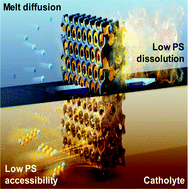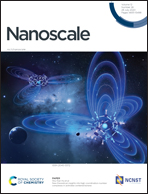Design considerations for lithium–sulfur batteries: mass transport of lithium polysulfides†
Abstract
Irreversible loss of soluble lithium polysulfides (LiPSs) is a major obstacle deteriorating the performance of lithium–sulfur batteries. Multiple innovative approaches have recently been developed to resolve these LiPS issues. Melt-diffusion of sulfur into porous carbon is a representative solution for preventing the diffusion out of LiPSs, which aims to coordinate the sulfur on the electrochemically active site, accordingly. However, it has been overlooked that the mass transport motion of LiPSs has a crucial role in achieving high-performance. In this paper, we highlight the importance of the mass transport of soluble sulfur in the cathode structure by introducing various starting materials, i.e., solid sulfur using melt-diffusion and a catholyte, using 3-dimensional ordered macroporous carbon. The capacity of the sulfur cathode using melt-diffusion is well conserved in carbon with small pores because LiPSs are slowly diffused away, however, the catholyte derived sulfur cathode shows superior performance in carbon with large pores due to their rapid mass transport. The comparison with the four different combinations that control the pore size and mass transport reveals that proper selection of the initial state of starting materials using porous carbons demonstrates the optimal cell performance.



 Please wait while we load your content...
Please wait while we load your content...